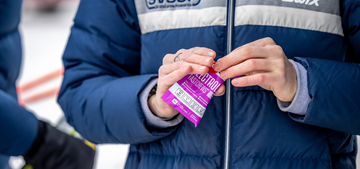
And three other questions you were too afraid to ask. Sometimes the simplest questions are the hardest to answer. Inquiries such as “why do we cry” or “where do goosebumps come from” may sound as if they belong in a children’s book, but a basic understanding of the human body has implications for sports performance. By improving knowledge of physiology, an athlete can more adequately prepare for training and racing. For instance, recognizing the difference between “sodium” and “salt” can help avoid misinterpretation of a coach’s nutrition advice, as these terms are frequently (but incorrectly) used interchangeably. Additionally, the answer to “why is there salt in sweat?” can help an athlete understand and manage the heat-adaptation process. In this blog post, we provide answers to these basic questions. We have also explained why caffeine boosts endurance performance and, in case you overdo your post-race celebration, whether or not salt can help with a hangover.
Why is there salt in sweat?
In early childhood, we learn about sweat’s salt content with our taste buds; however, as adults, few people know why salt is there the first place. Given that the salt does not evaporate and simply stays on the skin, it may seem counterintuitive that the body does not simply release pure water. The answer comes down to chemistry, specifically through a process called osmosis, which is the term used to describe the tendency of a fluid (usually water) to pass through a semipermeable membrane from a less concentrated solution to a more concentrated one, so that the concentrations are equalized on both sides of the membrane.
(Fun Fact: Osmosis is why salt is used to dry or cure meat by effectively dehydrating it; the high salt content draws water from the cells in a similar manner.) Sweat glands are tiny chambers under the skin, connected to the surface by a small tube, and encased in a semipermeable membrane. When the body becomes heated, these glands pump salt into the chambers, and the osmosis process draws water in through the chamber’s “walls.” With more water inside the chamber, the internal pressure rises, and the water and salt mixture is forced through the tube to the surface of the skin. It is on the surface that water can evaporate and thus cool the athlete. The body is pretty efficient at removing salt from this mixture before it reaches the surface, thus recycling the minerals to be used again. However, it is not perfect and small amounts of salt do escape the chamber. Over time, these amounts build up on the skin, resulting in a salty taste. Sweat typically has about 1,000 mg sodium per liter, and during the course of exercise, if an athlete does not replace these lost salts, he or she will not be able to perform at an optimal level. In addition to the sweating process, salts (also known as electrolytes) are crucial to a variety of physiological systems, including neurological functioning, muscular contraction and blood pressure regulation. When the body runs out of sufficient electrolyte stores, at minimum, it is forced to slow down. Worse side effects include headaches, cramping or hyponatremia, a medical condition marked by low blood sodium levels that can lead to nausea, fatigue, vomiting, weakness, sleepiness, and in rare severe cases, even death. What is lost in sweat should be replaced in a quantity and form which your body can absorb. Even though sweat typically has about 1000 mg sodium/liter, most sports drinks have 440 mg sodium/liter. If, during the course of training, you ingest nothing but sports drinks (or worse, water), you will become hyponatremic at some point. Instead, an athlete should ensure he or she is replacing a sufficient amount of sodium and other electrolytes to maintain proper electrolyte levels. For example, SaltStick Caps have been formulated to provide your body with a balanced electrolyte content in the suggested serving of 1 capsule per 30-60 minutes. Two SaltStick Caps in an hour equate to 430 mg sodium, 126 mg potassium, 22 mg magnesium, and 44 mg calcium per hour: The ideal ratio to keep you moving. (For a complete SaltStick usage guide, please go here.) An athlete should also keep in mind the following: Heat adaptation: An athlete can train his or her body to become more efficient at the process of recycling salt. As you adapt to a heated environment, the salt concentration in your sweat becomes lowered (almost 30 percent lower, according to a 2008 study of male runners), and you will lose salt more slowly. This is why it is important to train in a climate similar to your upcoming race, if possible, in order to prepare your body to operate efficiently. Concentration in your sweat: Different people have different salt concentrations in their sweat, and these concentrations are not affected by diet. It is important to pay attention to your own sweat’s sodium concentration. As a 2016 study found, high sodium concentrations in sweat correlated with low sodium concentrations in the blood after a marathon. If you are a salty sweater, you will have to take extra precaution to replace lost electrolytes during exercise, in order to sustain performance.
Why does caffeine boost performance?
Approximately 75 percent of Americans drink coffee on a regular basis, and Rice University calls caffeine “the most widely used stimulant drug in the world,” usually ingested in the form of coffee, tea, soft-drinks and chocolate. Additionally, SaltStick Caps PLUS contain 30 mg caffeine per capsule, for a legal ergogenic boost. Caffeine has been show in many studies to act as an aid to sports performance, increasing sprint performance, strength, alertness and endurance. Caffeine’s main effect on endurance athletes is two-fold. First, caffeine slows the rate at which the body burns glycogen in the muscle cells and increases the rate of fat burning. During endurance exercise, the body relies on a mixture of glycogen and fat to assist with muscle contraction. The ratio of glycogen to fat usually correlates with effort, in that high-intensity exercise utilizes higher levels of glycogen than low-intensity exercise. While even the thinnest athletes have enough fat stores to fuel many, many hours of movement, glycogen stores are limited and usually become depleted after three hours of sustained exercise, unless the athlete takes steps to replenish carbohydrate. The body requires both glycogen and fat for performance, and once glycogen stores run out, an athlete must slow down, regardless of his or her level of fat stores available. Therefore, it is the rate of glycogen burning that dictates endurance ability. Endurance training increases the body’s stores of glycogen (meaning a greater quantity of glycogen will be available) and also reduces the rate of glycogen burning in comparison to fat burning. Caffeine has the same effect – by lowering the amount of glycogen burning during endurance exercise, caffeine helps the body preserve glycogen and thus boost overall endurance. The result is that after ingesting caffeine, athletes are able to exercise longer until exhaustion. Second, caffeine reduces an athlete’s perceived effort. An athlete’s mental state has vast implications on his or her ability to perform, and perceived exertion (or how hard you feel you are working) can impact athletic output. Caffeine lowers perceived exertion and convinces your mind that you are not working as hard, meaning you are more resistant to fatigue.
What is the difference between sodium and salt?
Sodium and salt are not the same. If your coach prescribes a nutrition plan that includes a certain amount of salt per hour, be sure to clarify exactly what he or she is suggesting. “Salt” is usually what people call sodium chloride, which is about 40 percent by weight sodium. This means that the 550 mg of sodium chloride in a capsule of SaltStick Caps represents an available 215 mg of elemental sodium (the remaining 335mg is chloride). Other sources of sodium have different amounts of sodium by weight. For example, the 810 mg of sodium citrate in SaltStick Caps Plus represents 190 mg of elemental sodium. Therefore, when you compare labels or intake goals, be sure to compare just the elemental sodium values.









